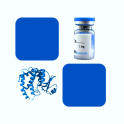
- Remove this product from my favorite's list.
- Add this product to my list of favorites.
Products
Newsletter
 |  |  |  |  |  |

Background
The MERS or Middle East Respiratory Syndrome Coronavirus, is a member of the coronavirus family and is known to cause severe respiratory illness in humans. The MERS protein is a type I transmembrane protein that plays a vital role in the virus's ability to infect host cells. It is composed of three main domains: the extracellular domain, the transmembrane domain, and the cytoplasmic domain. The extracellular domain, further divided into S1 and S2 subunits, is responsible for receptor recognition and binding. The S1 subunit contains the Receptor Binding Domain (RBD), which is crucial for the virus's attachment to and entry into host cells. The RBD specifically interacts with the host cell receptor, facilitating the initial step of infection. The S2 subunit, on the other hand, is responsible for membrane fusion. It contains a fusion peptide that inserts into the host cell membrane, initiating the fusion process. This fusion allows the virus's genetic material to be released into the host cell, initiating the infection process.
Source
Recombinant MERS S1 protein, His Tag (S1N-M52H5) is expressed from human 293 cells (HEK293). It contains AA Tyr 18 - Arg 751 (Accession # K0BRG7-1).
Predicted N-terminus: Tyr 18
Molecular Characterization
This protein carries a polyhistidine tag at the C-terminus.
The protein has a calculated MW of 83.1 kDa. The protein migrates as 90-116 kDa under reducing (R) condition (SDS-PAGE) due to glycosylation.
Endotoxin
Less than 1.0 EU per μg by the LAL method.
Purity
>95% as determined by SDS-PAGE.
Formulation
Lyophilized from 0.22 μm filtered solution in PBS, pH7.4 with trehalose as protectant.
Reconstitution
Please see Certificate of Analysis for specific instructions.
For best performance, we strongly recommend you to follow the reconstitution protocol provided in the CoA.
Bioactivity
Please refer to product data sheet.
Storage
For long term storage, the product should be stored at lyophilized state at -20°C or lower.
Please protect from light and avoid repeated freeze-thaw cycles.
This product is stable after storage at:
-20°C to -70°C for 12 months in lyophilized state;
-70°C for 3 months under sterile conditions after reconstitution.
(1) "Investigation of IgG Titers in Hemodialysis Patients and Controls Following Administration of the COVID-19 Vaccine"
Jozpanahi, Jafari, Moharrer et al
Int Tinnitus J (2024) 27 (2), 183-190
(2) "Functional dissection of the spike glycoprotein S1 subunit and identification of cellular cofactors for regulation of swine acute diarrhea syndrome coronavirus entry"
Yang, Wang, Li et al
J Virol (2024)
(3) "Characteristics of neutralizing antibody titers of the SARS-CoV-2 vaccine in maintenance hemodialysis patients"
Amari, Morimoto, Teranishi et al
Clin Nephrol (2024)
Showing 1-3 of 2946 papers.
Follow us